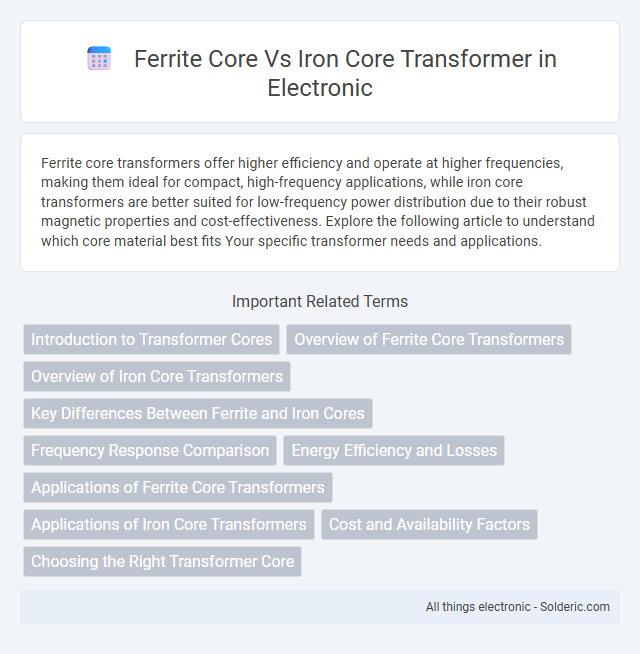Ferrite core transformers offer higher efficiency and operate at higher frequencies, making them ideal for compact, high-frequency applications, while iron core transformers are better suited for low-frequency power distribution due to their robust magnetic properties and cost-effectiveness. Explore the following article to understand which core material best fits Your specific transformer needs and applications.
Comparison Table
| Feature | Ferrite Core Transformer | Iron Core Transformer |
|---|---|---|
| Core Material | Ferrite (ceramic compound of iron oxides) | Silicon steel laminated sheets |
| Frequency Range | High frequency (10 kHz to MHz) | Low frequency (50 Hz to 60 Hz) |
| Magnetic Losses | Low core losses at high frequencies | Higher core losses due to eddy currents |
| Size & Weight | Smaller and lighter | Larger and heavier |
| Applications | Switch mode power supplies, RF transformers | Power distribution, audio transformers |
| Cost | Generally higher cost per unit | Lower cost, especially in bulk |
Introduction to Transformer Cores
Transformer cores are essential components influencing efficiency, magnetic properties, and frequency performance. Ferrite cores, composed of ceramic-like magnetic materials, offer low core loss and high magnetic permeability, making them ideal for high-frequency applications like switch-mode power supplies. Iron cores, typically made from laminated silicon steel, provide higher magnetic flux capacity and are preferred in low-frequency transformers such as power distribution units; your choice depends on operating frequency and efficiency requirements.
Overview of Ferrite Core Transformers
Ferrite core transformers use ferrite, a magnetic ceramic material with high electrical resistivity and low eddy current losses, making them ideal for high-frequency applications such as switching power supplies and RF circuits. These cores exhibit lower hysteresis loss and provide efficient energy transfer at frequencies ranging from tens of kilohertz to several megahertz. In contrast to iron core transformers, ferrite cores enable compact, lightweight designs while maintaining excellent magnetic performance in high-frequency environments.
Overview of Iron Core Transformers
Iron core transformers consist of laminated iron sheets to minimize eddy current losses, providing high magnetic permeability for efficient energy transfer in low-frequency applications. They are commonly used in power distribution and heavy electrical equipment due to their robustness and ability to handle high voltages and currents. The core's construction ensures stable performance in applications such as power supplies, audio devices, and industrial machinery.
Key Differences Between Ferrite and Iron Cores
Ferrite cores exhibit higher electrical resistivity and lower eddy current losses compared to iron cores, making them ideal for high-frequency transformer applications. Iron cores provide better magnetic permeability and saturation flux density, which enhances their efficiency in low-frequency and power distribution transformers. The choice between ferrite and iron cores depends on the operating frequency, with ferrite cores preferred above 20 kHz and iron cores favored below this threshold for optimal performance.
Frequency Response Comparison
Ferrite core transformers offer superior frequency response at high frequencies, typically above 20 kHz, due to their low core losses and high magnetic permeability, making them ideal for switching power supplies and RF applications. Iron core transformers excel at low-frequency ranges, such as 50-60 Hz power distribution, because of their higher saturation flux density but suffer from increased eddy current losses and reduced efficiency at high frequencies. Selecting between ferrite and iron cores depends on the required operating frequency and application efficiency demands.
Energy Efficiency and Losses
Ferrite core transformers exhibit higher energy efficiency due to their low core losses and reduced hysteresis compared to iron core transformers, which experience greater eddy current and hysteresis losses. The ferrite material's high magnetic permeability and electrical resistivity minimize energy dissipation, making them ideal for high-frequency applications. Iron core transformers, while robust for low-frequency power distribution, suffer from increased core losses that reduce overall efficiency, especially under varying load conditions.
Applications of Ferrite Core Transformers
Ferrite core transformers are extensively used in high-frequency applications such as switch-mode power supplies, radio frequency circuits, and signal processing due to their low core losses and high magnetic permeability. Their lightweight and compact design make them ideal for use in telecommunications, audio equipment, and computer power adapters. Ferrite cores also excel in reducing electromagnetic interference, enhancing the performance of electronic devices in consumer electronics and automotive industries.
Applications of Iron Core Transformers
Iron core transformers are widely used in power distribution networks, industrial machinery, and electrical substations due to their ability to handle high voltages and currents efficiently. Their robust magnetic properties make them ideal for applications requiring low-frequency operation, such as audio equipment, induction heaters, and heavy-duty electrical devices. When selecting a transformer for your industrial or power transmission needs, iron core designs provide durability and reliable performance under demanding conditions.
Cost and Availability Factors
Ferrite core transformers generally offer lower cost and wider availability due to their efficient mass production and use in high-frequency applications like power supplies and telecommunications. Iron core transformers tend to be more expensive because of the higher material costs and manufacturing complexity involved in achieving lower frequency performance for heavy-duty industrial uses. Availability of ferrite cores is greater in markets focused on compact, lightweight, and energy-efficient solutions, whereas iron cores are more common in traditional power distribution and heavy machinery sectors.
Choosing the Right Transformer Core
Choosing the right transformer core depends on the application's frequency and efficiency requirements, where ferrite cores excel in high-frequency operations due to low eddy current losses while iron cores are preferred in low-frequency, high-power settings for their magnetic saturation benefits. Ferrite cores offer lightweight, compact designs suitable for switch-mode power supplies, whereas iron cores provide robustness and higher inductance, ideal for power distribution and audio transformers. The decision should prioritize core material properties, including permeability, saturation flux density, and core loss, to optimize transformer performance and thermal management.
Ferrite core vs Iron core transformer Infographic

 solderic.com
solderic.com